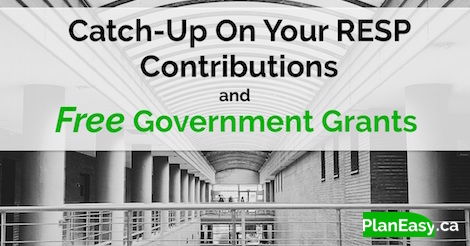Catch-Up On Your RESP Contributions and Free Government Grants
When you first have children, there is a lot going on. Sleep deprivation, diapers, crying, screaming, feeding, more diapers, cribs, car seats, more crying. It’s overwhelming. So it’s entirely understandable that making RESP contributions for your child is the last thing on your mind.
Even for someone like me, who’s a bit of a personal finance geek, opening an RESP and making contributions was the least of my concerns. For at least 12 months I put off opening an RESP.
Putting off opening an RESP for a little while is ok. But put it off too long and you may miss some free money from the government.
Here’s what you need to know about opening an RESP, making RESP contributions and catching up on the free money from the government.

What is an RESP?
An RESP is a tax-sheltered account that you can use to help save for your children’s education. The money invested within an RESP can grow tax free.
What can it be used for?
Funds within an RESP can be used for your child’s education. After high school your child can withdraw funds from the RESP to pay for full-time or part-time education in the following areas:
- an apprenticeship program
- a trade school
- a college or university
How much is the government grant?
The government will match 20% of your annual contribution up to $500. This is called the Canada Education Savings Grant or CESG.
Contributing $2,500 each year ensures you’ll get the maximum CESG.
There is a lifetime max on CESG. The maximum grant for each child is $7,200. Once you contribute $36,000 you will have reached the maximum government grant.
If you contribute $2,500 each year it will take 15 years to maximize the grant (14 plus a $1,000 contribution in the 15th year to be exact).
Related Posts:
What will my RESP be worth?
Let’s assume you contribute enough money to maximize the government grant but not a penny more.
Over the course of 15 years you will have made $36,000 in contributions and the government will have matched those contributions with $7,200 in grants.
By the time your child reaches university your RESP will have grown to be worth over $76,000 in today’s dollars.
[weblator_chart id=”4″]
How long is the grant available?
The CESG is available until the end of the year that the child turns 17.
Can you catch-up on prior years?
Yes. You can catch up on prior grant years one year at a time. Contribute $5,000/child and you will maximize the current year AND catch up on one prior year.
Because you can only catch up one year at a time it will take a minimum of 8 years to catch up on CESG assuming you’re starting from zero.
If you don’t start making catch up payments by the time the child is 10 years old you won’t be able to maximize the government grant because the grant ends the year the child turns 18.
Yes, it’s possible to put off opening an RESP, but don’t wait too long or you’ll be leaving free money on the table.
“The maximum Canada Education Savings Grant (CESG) is $7,200 for each child.”

“Even for someone like me, who’s a bit of a personal finance geek, opening an RESP and making contributions was the least of my concerns.”
Some more interesting RESP info…
- Lifetime maximum contribution is $50,000 per child
- Withdrawals are taxed in your child’s name
- Only part of the withdrawal is taxed. CESG and investment growth are taxed. Contributions are not taxed.
- It’s possible to specify what to withdraw; contribution, CESG or investment growth
- Parents can take back contributions with no tax impact or penalty
- Parents can take back investment growth but will be taxed at their regular tax rate PLUS a 20% penalty (ouch)
- Parents can avoid the 20% penalty by contributing RESP investment growth to their RRSP if they have contribution room (max of $50,000).
- Parents cannot take back CESG. If CESG is unused by the child the grant is lost
- Additional CESG is available for low income families. An additional 10-20% on the first $500 in contributions ($50-$100).
- An RESP can stay open for up to 36 years and the child can use it at any time, could be for a masters, an MBA or even a doctorate.
Join over 250,000 people reading PlanEasy.ca each year. New blog posts weekly!
Tax planning, benefit optimization, budgeting, family planning, retirement planning and more...
Join over 250,000 people reading PlanEasy.ca each year. New blog posts weekly!
Tax planning, benefit optimization, budgeting, family planning, retirement planning and more...






Good info on RESP. We have a similar program here in the United States (529 Plans). I’m all about the tax-advantaged accounts so you know I will be contributing to a 529 when I have kids.
Tax advantaged accounts are great, hopefully the 529 plan is also a bit flexible in how they can be used. Thanks for your comment DC.
I really wish the government had made their web page this clear! Such a helpful blog post!
You forgot to mention the Additional CESP, which amounts to a whopping additional $50 a year or so (yay).
https://www.canada.ca/en/employment-social-development/services/student-financial-aid/education-savings/resp/resp-promoters/user-guide/section4.html#acesg
Thanks for your comment Dominika! And thanks for pointing out the Additional CESG. I should have added that. I’ll add that to the post now. Thanks!
>It’s possible to specify what to withdraw; contribution, CESG or investment growth
I’ll just clarify that when you are withdrawing you can specify if you want to withdraw from the contribution portion or to receive an Educational Assistance Payment (EAP.) The EAPs are comprised of the government incentives and the accumulated income but the subscriber can’t specify how much of the EAP is from the incentives vs. the accumulated income. The proportion of each will reflect their relative value in the RESP.
> it will take a minimum of 8 years to catch up on CESG assuming you’re starting from zero.
If the beneficiary qualifies for ACESG of $100 then each $5000 contribution would trigger CESG + ACESG of $1200 and the maximum $7200 could be achieved in just 6 years. (Starting in the calendar year the beneficiary turns 12.)
Hi Tom, great clarifications, my wording wasn’t very precise. I’ll make a note to update this post in the future. Thanks!
Well done
Thanks Sam!
What happens if you put the maximum (50 000$) in the first year? Will the government only put 20% of 2500$ for one year only? Or will they keep giving the benefit every year until the threshold is met?
Hi Alex, good question! Unfortunately the maximum CESG is only $500 per year, so regardless of the size of contribution, $2,500 or $50,000, the maximum grant is $500. Typically we look at scenarios where $16,500 is contributed on day 1 ($2,500 for the grant and $14,000 extra to maximize the lifetime contribution limit) and then additional contributions of $2,500 per year are made for the following years to maximize the grant.
Thanks for the clear description of RESP. So to retroactively claim CESG, we just need to deposit $5000 instead of $2500? Searched for this around and only could find it here… Other posts usually say that you can only get CESG for the first $2500 each year, which is quite misleading.
Hi Chris, that is correct. If you have CESG to catch up on then you can do double contributions to get double the grant (catching up one year at a time). To remove any doubt you can call the Canada Education Savings Program, and you will need your child’s social insurance number as well as your own. When you call in you can ask them how much you need to contribute to maximize the grant, they’re very helpful.